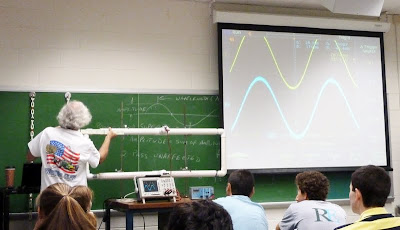Today began like the days before it, with a shower, breakfast, and then a walk to class. Once we got to class for the day however, things changed. Instead of a brief lecture and then labwork, Bill’s lecture was a bit longer than usual.
Because we had begun discussing the duality of light (how light is both a particle and a wave), today we learned about waves. Bill began not with the definition as many teachers might, but with many examples of waves. He had a cool demonstration tool where we could easily see a wave traveling along. He then transitioned into more complex topics such as how, when waves meet, depending if they are in phase or not, they cancel or reinforce each other. An effective demonstration of this was a large circuit of PVC pipe that Bill constructed himself. At one part of the circuit, a speaker was mounted, and it was set to play at only one pitch. Because the speaker was centered, and the opening in the PVC where the sound could get out was equidistant from both sides, the waves from the speaker split, and then went opposite ways around the circuit until they collided. Once the waves collided, we could clearly hear the canceling effect of the waves. Similarly, when the PVC on one side of the circuit was pulled out a bit so that the wave going that way had to go longer, the waves collided in phase, and the sound was amplified.
After this, we began a quick lab where with the objective of determining the wavelength of a laser we were given. By splitting a laser beam into two beams, measuring several different angles and lengths of the beam, and doing some trig, we calculated the wavelength of the beam. This was a cool lab, but we all had our minds set on the field trip of the day, the Simeone Foundation car museum. I went to lunch with some friends, and soon enough, we were boarding a bus to the museum.
We arrived at the museum just in time for some torrential rain. It was weird to have a downpour when it was still almost 80 degrees out, but it was fun to have a change in weather, and soon enough we were inside the museum. Inside the museum, Bill and his assistants had set up a bunch of tracks on the floor, and had a large pile of brooms and bowling balls set out.
The purpose of the experiments was really to solidify the idea of inertia in our heads. While anyone can recite the definition of inertia as, “the resistance of any physical object to a change in its state of motion or rest”—which I frequently use as an excuse for not wanting to get out of bed—this lab really helped show what inertia is. By rolling a bowling ball down a ramp, and then only being able to use a broom to push the ball, we had to steer the ball along many curvy tracks. All of us quickly realized that keeping control of the bowling balls was difficult, and that even though we were racing the clock, speed was not the way to finish first.
Our experiments were a lot of fun, but when you’re interested in cars, and there is about a quarter of a billion dollars worth of classic sports cars around you, you tend to get distracted. I saw car after car that had won various international races, set speed records, and simply were full of innovative ideas and technology. Involved in these cars were thousands of physics principles such as spoilers to create a downward force, fancy tires to get better traction, and careful weight distribution for fast cornering. I could describe these cars for hours, but I'll throw in a couple pictures instead.






Brian,
ReplyDeleteThis may be coincidental but I think I used to have a car just like that silver one when I was about your age. It went through oil pretty quick so I traded it in on something more economical. That and I could never get used to driving on with the steering wheel on the wrong side of the car.
That wasn't one of those super expensive cars was it?